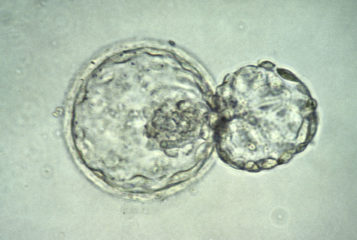Scientists at the University of Newcastle are applying for a licence to create embryos with 'three parents', in order to prevent genetic conditions caused by faults in the 'powerhouses' of the cell. Doug Turnbull and Mary Herbert have submitted an application to the UK's Human Fertilisation and Embryology Authority, which will be considered over the next few weeks. They want to remove the nucleus from a fertilised egg, and transplant it into another, unfertilised egg that has had its own nucleus removed. In this way, they hope to replace the fertilised egg's faulty mitochondria - tiny structures found in a cell that are responsible for energy production.
Mitochondria contain around 35 genes, and several inherited diseases are caused by mutations in this DNA. The researchers hope that by transferring the nucleus of a cell that has faulty mitochondria to a healthy egg cell, they will be able to develop a new treatment for these mitochondrial disorders. But critics are alarmed by the move, since it would result in embryos that have a tiny amount of DNA from the egg donor, as well as its own parents. 'By creating a child with three genetic parents, these scientists are taking the first step towards genetic engineering of human beings', said David King of Human Genetics Alert. However, Leon Kass, chairman of the US President's Council on Bioethics, says this label is a red herring. 'I think that it is for my own tastes stretching the idea of genetic engineering', he told New Scientist magazine, but added that he would 'be inclined to be cautious' in this area of work.
Herbert says that the team will not apply for a licence to use the technique to treat patients until 'we can demonstrate absence of known harmful effects'. She also said that they respected the views of people who feel that no research should be carried out on human embryos, but added that 'it could be argued that there is a moral obligation to reduce suffering in children at risk of inheriting mitochondrial disease'. Last year, a group of researchers based in China reported that they had used the technique to try and help a woman undergoing in IVF, whose fertilised eggs would not develop past the two-cell stage. However, none of the embryos survived beyond the 29th week of pregnancy, for reasons apparently unrelated to the method of their creation.
Meanwhile, researchers in Taiwan say they have found a way to improve the chances of IVF success for some women, by using mitochondria taken from their own cells. The technique, presented at the American Society for Reproductive Medicine in Philadelphia, involves injecting mitochondria taken from cumulus cells, which surround developing eggs in the ovary, and injecting them into the woman's eggs in the laboratory. Of 71 IVF treatment attempts using the technique, 35 per cent resulted in a pregnancy and 20 babies have been born, reported team leader Chii-Ruey Tzeng, of Taipei Medical University. 'I think it can rescue a lot of patients', he said, although other fertility experts say more research is needed into the safety and effectiveness of the method.
Sources and References
-
Now there's Mum and Dad and Mum...
-
Second bid made to clone humans
-
Egg injection boosts fertility
-
Scientists seek to create 'three-parent' babies





Leave a Reply
You must be logged in to post a comment.